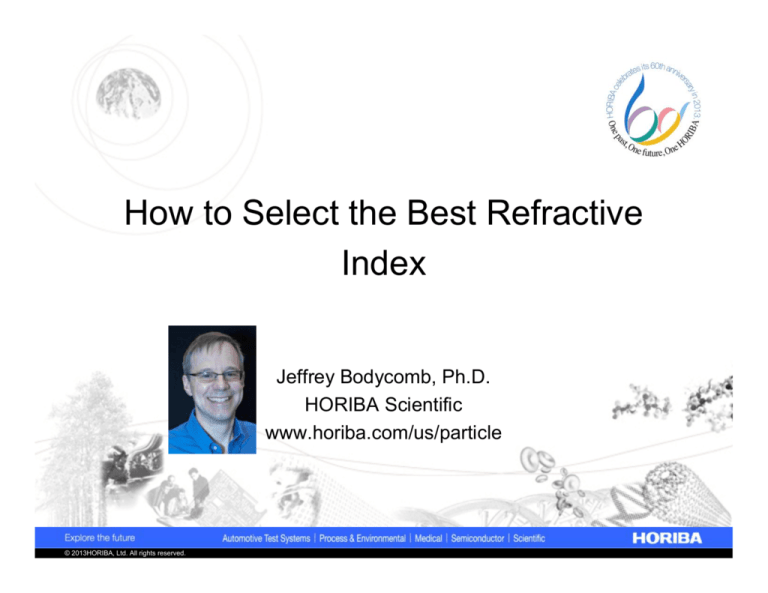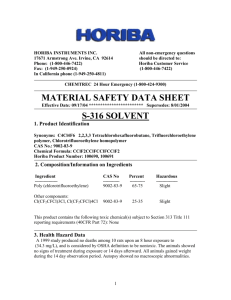
How to Select the Best Refractive
Index
Jeffrey Bodycomb, Ph.D.
HORIBA Scientific
www.horiba.com/us/particle
© 2013HORIBA, Ltd. All rights reserved.
Outline
Laser Diffraction Calculations
Importance of Refractive Index
Choosing Refractive Index
Comparing Methods for Choosing
Refractive Index
© 2013 HORIBA, Ltd. All rights reserved.
Outline
Laser Diffraction Calculations
Importance of Refractive Index
Choosing Refractive Index
Comparing Methods for Choosing
Refractive Index
© 2013 HORIBA, Ltd. All rights reserved.
LA-950 Optics
© 2013 HORIBA, Ltd. All rights reserved.
When a Light beam Strikes a Particle
Some of the light is:
Diffracted
Reflected
Refracted
Absorbed and
Reradiated
Reflected
Refracted
Absorbed
and
Reradiated
Diffracted
Small particles require knowledge of optical properties:
Real Refractive Index (bending of light)
Imaginary Refractive Index (absorption of light within particle)
Refractive index values less significant for large particles
Light must be collected over large range of angles
© 2013 HORIBA, Ltd. All rights reserved.
Diffraction Pattern
© 2013 HORIBA, Ltd. All rights reserved.
Using Models to Interpret
Scattering
Scattering data typically cannot be
inverted to find particle shape.
We use optical models to interpret data
and understand our experiments.
© 2013 HORIBA, Ltd. All rights reserved.
The Calculations
There is no need to know all of the
details.
The LA-950 software handles all of the
calculations with minimal intervention.
© 2013 HORIBA, Ltd. All rights reserved.
Laser Diffraction Models
Large particles -> Fraunhofer
More straightforward math
Large, opaque particles
Use this to develop intuition
All particle sizes -> Mie
Messy calculations
All particle sizes
© 2013 HORIBA, Ltd. All rights reserved.
Fraunhofer Approximation
dimensionless size parameter = D/;
J1 is the Bessel function of the first kind of order unity.
Assumptions:
a) all particles are much larger than the light wavelength (only scattering at the contour of
the particle is considered; this also means that the same scattering pattern is obtained as for
thin two-dimensional circular disks)
b) only scattering in the near-forward direction is considered (Q is small).
Limitation: (diameter at least about 40 times the wavelength of the light, or >>1)*
If =650nm (.65 m), then 40 x .65 = 26 m
If the particle size is larger than about 26 m, then the Fraunhofer approximation gives
good results. Rephrased, results are insensitive to refractive index choice.
© 2013 HORIBA, Ltd. All rights reserved.
Mie Scattering
I0
2
2
I s (m, x, ) 2 2 S 2 S1
2k r
Use an existing computer program for the calculations!
2n 1
an n bn n
S1 (m, x, )
1 n( n 1)
2n 1
an n bn n
S 2 (m, x, )
n
n
(
1
)
1
an
m n (mx) n ' ( x) n ( x) n ' (mx)
m n (mx) n ' ( x) n ( x) n ' (mx)
bn
n (mx) n ' ( x) m n ( x) n ' (mx)
n (mx) n ' ( x) m n ( x) n ' (mx)
© 2013 HORIBA, Ltd. All rights reserved.
Pn1 (cos )
n
sin
d 1
n
Pn (cos )
d
: Ricatti-Bessel
functions
Pn1:1st order Legendre
Functions
Mie
The equations are messy, but require just three inputs which are
shown below. The nature of the inputs is important.
x D
m
np
© 2013 HORIBA, Ltd. All rights reserved.
nm
Decreasing wavelength is the same as
increasing size. So, if you want to measure
small particles, decrease wavelength so they
“appear” bigger. That is, get a blue light
source for small particles.
We need to know relative
refractive index. As this goes to 1
there is no scattering.
Scattering Angle
Effect of Size
As diameter increases, intensity (per particle) increases
and location of first peak shifts to smaller angle.
© 2013 HORIBA, Ltd. All rights reserved.
Mixing Particles? Just Add
The result is the weighted sum of the scattering from each particle.
Note how the first peak from the 2 micron particle is suppressed since it
matches the valley in the 1 micron particle.
© 2013 HORIBA, Ltd. All rights reserved.
Outline
Laser Diffraction Calculations
Importance of Refractive Index
Choosing Refractive Index
Comparing Methods for Choosing
Refractive Index
© 2013 HORIBA, Ltd. All rights reserved.
What do we mean by RI?
Optical properties of particle different from surrounding medium
Note that intensity and wavelength of light changes in particle
(typical dispersants do not show significant absorption)
Wavelength changes are described by real component
Intensity changes are described by imaginary component
n = 2-0.05i
n = 1 (for air)
© 2013 HORIBA, Ltd. All rights reserved.
Effect of RI: imaginary term
As imaginary term (absorption) increases location of first
peak shifts to smaller angle.
© 2013 HORIBA, Ltd. All rights reserved.
Effect of RI: Real Term
It depends….
© 2013 HORIBA, Ltd. All rights reserved.
Practical Application: Glass Beads
© 2013 HORIBA, Ltd. All rights reserved.
Practical Application: CMP Slurry
© 2013 HORIBA, Ltd. All rights reserved.
Effect of RI: Cement
Fixed absorbance, vary real
© 2013 HORIBA, Ltd. All rights reserved.
Fixed real, vary absorbance
Refractive Index Effect
Most pronounced when:
Particles are spherical
Particles are transparent
RI of particle is close to RI of fluid
Particle size is close to wavelength of light source
Least pronounced when:
Particles are not spherical
Particles are opaque
RI of particle is larger than RI of the fluid
Particle size is much larger than wavelength of the light source
© 2013 HORIBA, Ltd. All rights reserved.
Outline
Laser Diffraction Calculations
Importance of Refractive Index
Choosing Refractive Index
Comparing Methods for Choosing
Refractive Index
© 2013 HORIBA, Ltd. All rights reserved.
Abbe Refractometer
Dissolve sample at
different concentrations
Plot conc. vs. RI
Extrapolate to infinite
concentration
Refractive Index
1.8
1.6
1.5
1.4
1.3
0
© 2013 HORIBA, Ltd. All rights reserved.
0.2
0.4
0.6
Concentration
0.8
1.0
Becke Lines
Bright line is called the Becke line and will always occur closest to
the substance with a higher refractive index
© 2013 HORIBA, Ltd. All rights reserved.
Becke Line Test
As you move away from the thin section (raising the objective or lowering the stage),
the Becke Line appears to move into the material with greater refractive index.
A particle that has greater refractive index than
its surroundings will refract light inward like a
crude lens.
A particle that has lower refractive index than
its surroundings will refract light outward like a
crude diverging lens.
© 2013 HORIBA, Ltd. All rights reserved.
Becke Line Test
© 2013 HORIBA, Ltd. All rights reserved.
Luxpop.com
Note RI is dependent on
wavelength of light.
Can adjust RI for red &
blue light, but only need
to for small, absorbing
particles.
© 2013 HORIBA, Ltd. All rights reserved.
Google Search
© 2013 HORIBA, Ltd. All rights reserved.
Using R Value for i
© 2013 HORIBA, Ltd. All rights reserved.
What is R parameter?
yi is the measured scattering at detector I
y(xi) is the scattering data at detector i calculated from the
size distribution
N is the number of detector channels used in the
calculation.
© 2013 HORIBA, Ltd. All rights reserved.
Changing RI
© 2013 HORIBA, Ltd. All rights reserved.
Changing RI
© 2013 HORIBA, Ltd. All rights reserved.
Changing RI
© 2013 HORIBA, Ltd. All rights reserved.
Using R Value for i
Real component = 1.57 via Becke line
Vary imaginary component, minimize Chi square & R parameter
© 2013 HORIBA, Ltd. All rights reserved.
Automation by Method Expert
Analytical conditions
Calculation conditions
View Method Expert webinar
TE004 in Download Center
© 2013 HORIBA, Ltd. All rights reserved.
Automated RI Computation
Real part study
Need to fix imaginary part
Set up to 5 real parts
Software will compute all RI and display R parameter
variation with RI selection
© 2013 HORIBA, Ltd. All rights reserved.
Automated RI Computation
© 2013 HORIBA, Ltd. All rights reserved.
Automated RI Computation
© 2013 HORIBA, Ltd. All rights reserved.
Summary
Measure sample, recalculate w/different RI –
see how important it is
Use one of the described approaches to
determine the real component
Recalculate using different imaginary
component
Choose result that minimizes R parameter,
but also check if result makes sense
You wish you had Method Expert by your side
© 2013 HORIBA, Ltd. All rights reserved.
Outline
Laser Diffraction Calculations
Importance of Refractive Index
Choosing Refractive Index
Comparing Methods for Choosing
Refractive Index
© 2013 HORIBA, Ltd. All rights reserved.
Study on TiO2
Look up real refractive index, use R parameter to find imaginary.
© 2013 HORIBA, Ltd. All rights reserved.
Effect of RI on R parameter
© 2013 HORIBA, Ltd. All rights reserved.
Effect of RI on measured
D50
© 2013 HORIBA, Ltd. All rights reserved.
Effect of RI on measured
D10
© 2013 HORIBA, Ltd. All rights reserved.
Effect of RI on measured
D90
© 2013 HORIBA, Ltd. All rights reserved.
© 2013 HORIBA, Ltd. All rights reserved.
Results
Model
2.7 - 0.001i
(correct value)
2.6 - 0.001i
Fraunhofer
Minimize R
parameter
(3.25 - 0.1i)
© 2013 HORIBA, Ltd. All rights reserved.
D10,
Difference
microns from
correct
value
0.30
0.42
0.30
0.41
0.26
0.45
0.57
0.37
0%
37%
13%
D50,
microns
Difference
D90,
Difference
from correct microns from correct
value
value
0.80
7.1%
36%
12%
0.78
0.81
0.72
2.5%
1.2%
10%
Recommendations
Use the Mie model when evaluating laser
diffraction data.
Search for literature for real and imaginary
refractive index values or measure your
sample yourself.
If literature values are not available, use the
data to estimate values, it is better than
guessing or using the Fraunhofer model.
Once you choose a refractive index value,
stick with it.
© 2013 HORIBA, Ltd. All rights reserved.
Q&A
Ask a question at labinfo@horiba.com
Keep reading the monthly HORIBA Particle
e-mail newsletter!
Visit the Download Center to find the video and slides
from this webinar.
Jeff Bodycomb, Ph.D.
P: 866-562-4698
E: jeff.bodycomb@horiba.com
© 2013 HORIBA, Ltd. All rights reserved.
Thank you
© 2013 HORIBA, Ltd. All rights reserved.
ありがとうございました
Cảm ơn
ขอบคุณครับ
Dziękuję
谢谢
Gracias
ُ ا
ش ْكر
Tacka
감사합니다
© 2013 HORIBA, Ltd. All rights reserved.
Grazie
Σας ευχαριστούμε
धन्यवाद
நன்ற
Danke
Большое спасибо
Obrigado






